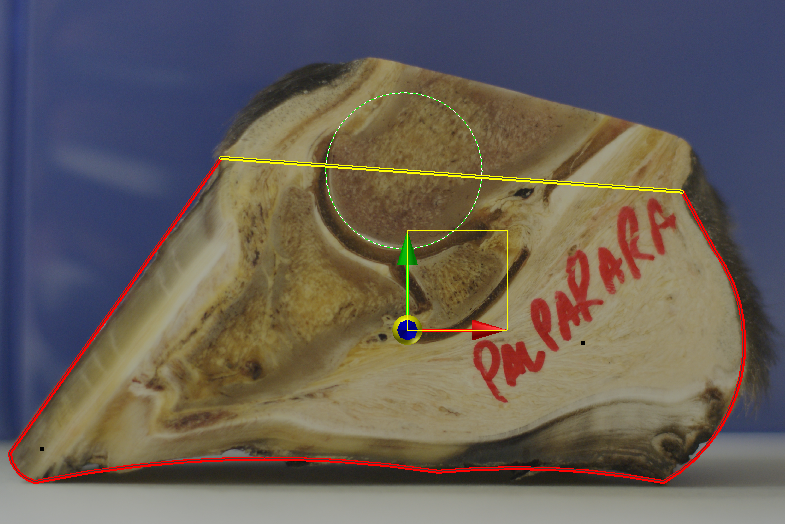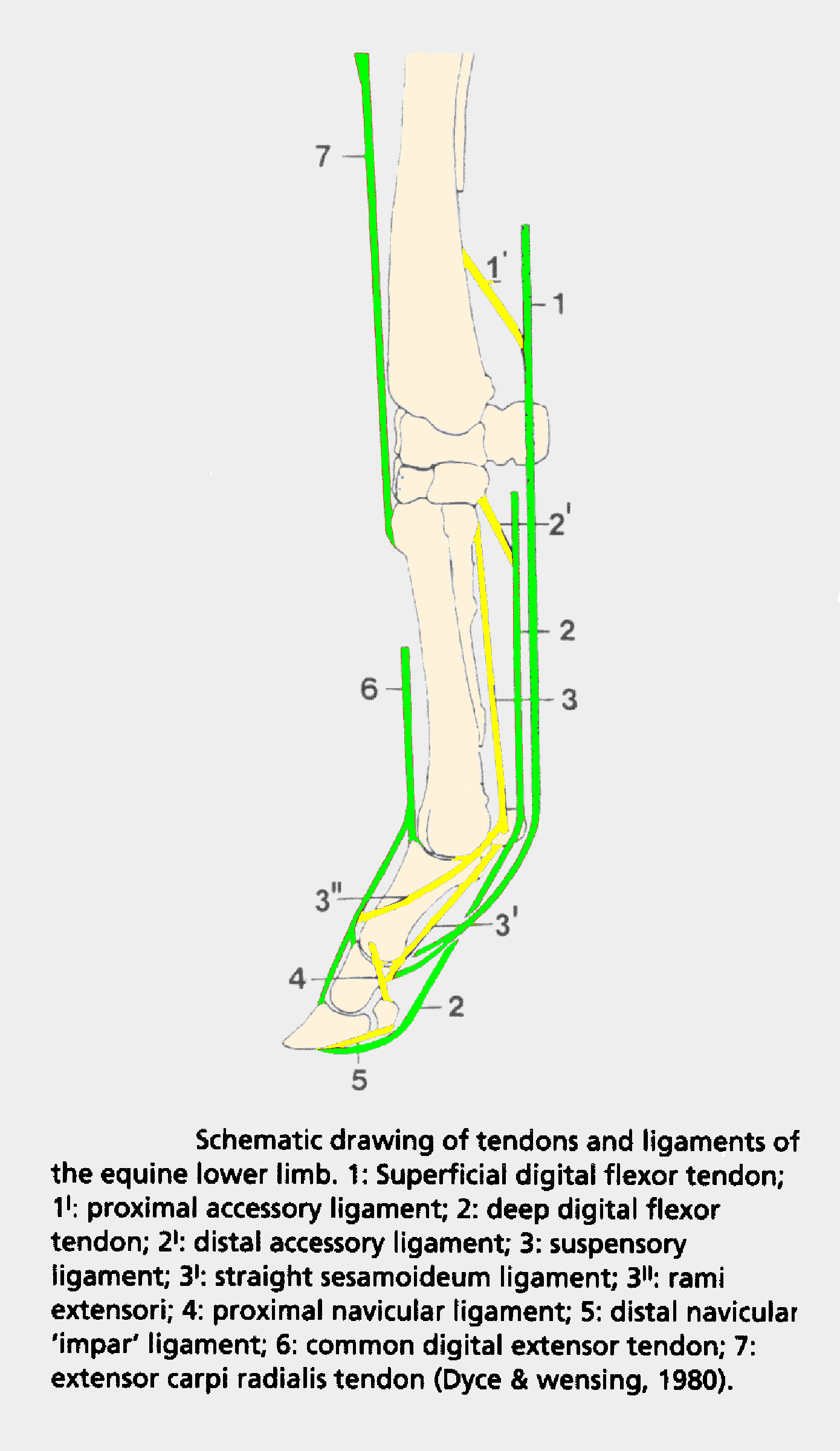In the first article in this series, I started us down the path to understanding why the proper landing for a horse at the walk has to be flat-footed by describing the anatomical differences between humans and horses, and pointing out the limitations of our ability to perceive fairly significant differences in how the horse lands without using slow-motion video techniques. In this installment, we’ll continue on by examining the orientation of the foot as it travels through the flight arc and prepares to make ground contact.
As you’ll note in the diagram above, the common digital extensor tendon (6) and the deep digital flexor tendon (2) both have insertions (attachments) on the coffin bone – the most distant (distal) bone in the horse’s limb that resides inside the hoof capsule. Like humans, the horse’s foot is stabilized by these tendons as well as ligaments, and, shortly after leaving the ground, its orientation to the rest of the limb immediately above it (long & short pasterns) remains essentially constant throughout most of the flight arc. And like us, horses don’t typically think about where to place the next foot when they walk. So although the tendons stabilize the position of the foot, the attached muscles do not actively pull or relax to reorient it as it prepares to land. In fact, James Rooney’s Biomechanics of Lameness in Horses, which I’ve referenced a number of times before, describes Dr. Rooney’s somewhat counter-intuitive discovery that transecting the extensor and deep flexor tendons in the vicinity of the short pastern really had no significant effect on the orientation of the hoof as it landed. He concluded, therefore, that (like humans) foot placement in “normal” walking is not an active effort. Keep in mind, by the way, that we’re talking only about A/P orientation in the horse; the M/L orientation, as we saw in Part 1, is dictated by the construction of the joint surfaces themselves.
Dr. Rooney’s comments inspired to me look at the center of coffin joint rotation and the center of gravity of a properly-trimmed bare foot, which is fairly easy to do with my CAD system by importing an image of a sagittally-cut foot, visually noting the center of joint rotation, and tracing the foot’s outline so the software can then compute the center of gravity. Check out the images below of one of Brian Hampson’s feral horse feet from Australia/New Zealand. And as an interesting aside, also note the bone remodeling evident at the tip of the coffin bone –

The center of coffin joint rotation (the circle’s center) lies on a line indicating the top of the foot

After outlining the foot, the software calculates the foot’s center of gravity, which lies directly below the center of joint rotation
The interesting thing about this observation is that it was consistent for all of the feet I looked at in cross-section, regardless of their toe angle. What this means is that the hoof balanced for a proper (flat) landing is quite literally “hung in balance” on the end of the limb! Thus, Dr. Rooney’s experience with the severed tendons makes sense; because the mass of a properly-trimmed bare foot is, by design, evenly distributed in the A/P direction, the tendons are only providing a stabilizing (damping) force rather than actively controlling pastern/foot alignment. This is similar in function to the shock absorbers on an automobile; they don’t determine the position of the car body, but they help the body more quickly return to a neutral position after being displaced.
The point I’m trying to make is that the horse isn’t consciously “aiming” his foot so it hits the ground a particular way based on what’s happening with the bottom of his hoof. Instead, the orientation of the bones of his foot and leg are the consequence of masses, muscle tensions, and joint construction – all under the influence of gravity and other external forces (we’ll get there in a moment!). As designed, the hoof itself is bare, quite short, and (as we saw above) the mass distribution of the foot overall is quite even; therefore, it’s able to quickly accelerate and decelerate to a position of proper alignment with respect to the limb above it, aided by the “neutral” tensions in the tendons/muscles, as it travels through the flight arc. So given a properly-trimmed bare hoof, the net result is that the internal and external structures of the foot will be in proper alignment as the hoof prepares to contact the ground. Check out the following photo, taken from a video of a client, in which the hoof position has been captured as close to the ground as possible just before making contact –
Note, however, that I’ve been using the phrase “properly-trimmed bare hoof.” Within some particular range of variation from “proper,” the internal structures of the foot will still be in the correct orientation with respect to the leg and the ground, but the external structures will not be. You have only to look at the preceding photo to understand that if some part of the hoof is left long with respect to the other parts, the longer part will end up striking the ground first. So a long toe will yield a toe-first landing, and long heels will produce a heel-first landing. As you’ll learn in later articles when I discuss the origins of navicular disease, this is an extremely problematic situation because, by design, the coffin joint is not intended to be rotating at the instant of contact! But if a horse is contacting the ground any way other than flat, the coffin joint will, necessarily, be rotating when the hoof “slaps” the ground as the leg comes under load.
But the situation gets worse. Once the hoof exceeds this range of variation from “proper” (and I don’t pretend to know precisely what those limits are), the internal foot/limb orientation, and therefore the internal and external foot/ground orientation, will be further mitigated by three factors, particularly at the beginning and end of the flight arc. These are: 1) hoof length, 2) hoof weight (mass), and 3) hoof weight (mass) distribution.
Remember Newton’s First Law of Motion?
Every object in a state of uniform motion tends to remain in that state of motion unless an external force is applied to it.
Because the coffin joint is fairly flexible, departures from this “intended design” of a short, properly-balanced bare hoof can have a significant effect on the motion of that joint during the flight arc, with profound consequences on the form of the landing. Probably nearly every horse owner has handled a horseshoe before, but relatively few have held a cadaver horse foot; I can assure you that most steel shoes are a significant percentage of the weight of a foot! And as we add weight to the end of the limb in the form of excess untrimmed growth and/or (more significantly) a shoe, we start changing the dynamics of the flight arc. In essence, the lower limb of the horse begins to act more and more like a double pendulum – the long & short pasterns forming one pendulum suspended from the fetlock joint, and the foot with whatever extra weight has been left or added suspended from the coffin joint. The resulting motion, and the mathematics describing it, can be quite complicated, but we can make some general statements about the effects of length, mass, and mass distribution:
- As the length of the hoof increases, the time it takes to accelerate from the ground or decelerate for a landing increases. This is because the timing (period) of a pendulum is a function of its length; the longer the pendulum, the longer the period.
- As the mass of the hoof increases, the time it takes to accelerate from the ground or decelerate for a landing increases. This is a consequence of both the center of mass shifting away from the coffin joint, effectively lengthening the pendulum and therefore the period; and the increase in the rotational force (moment of inertia) on the coffin joint, to which the period is also proportional.
- As the mass distribution of the hoof moves away from being symmetrical, there will be increased unilateral A/P torsion forces on the joints, affecting both the effective length of the pendulum and the center of mass.
What does all that mean in practical terms? It means a foot designed to contact the ground in a particular orientation with respect to the limb above it may not be able to do so because whatever has been done (or not done) in the trimming/shoeing process has altered its dynamics. This is why a shod horse with obviously-long heels can have a reasonably-flat, or even toe-first, landing. The shoe, whose weight distribution has shifted the foot’s center of gravity toward the toe, is modifying the flight arc such that it’s keeping the toe from rotating properly right before contact. But when you remove the shoe, the horse immediately starts contacting the ground heel-first! Similarly, horses with any type of bar shoe, where the weight of the shoe is much more A/P symmetrical or even back-heavy (depending on the specific design – think about wedges!) tend to really come down heel-first, because the weight of the shoe is keeping the heel down plus the horse’s heels are already too long. And the added weight also increases stresses on joints and soft tissues, because that extra weight must be accelerated and decelerated with every step.
So we’ve now added yet another variable to the “landing picture.” Not only do horses not walk like humans, and not only can we not reliably observe landings at normal speed, but the landings we do observe can be a far cry from “proper” because of how the aforementioned factors can modify pastern/hoof alignment. But the problem is this: as Dr. Deb Bennett says, “What people come to see every day, they naturally come to consider ‘normal’…But what a culture or a nation comes to expect is usually common instead of normal.”
Please don’t fall into the trap of thinking that just because you observe a lot of heel-first landings, they’re supposed to land that way. Those landings are merely common, they’re not biologically normal! That’s simply not the way the equine limb is designed, and we’ll continue to provide further evidence to support this claim in the near future.
More to come…

